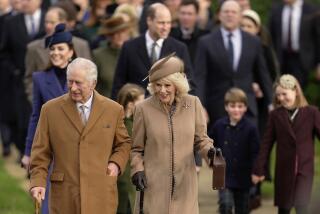Crown Prince to Take Over Duties of Ailing Hirohito : Three Blood Infusions for Emperor
- Share via
TOKYO — Emperor Hirohito, the world’s oldest and longest reigning monarch, was in serious but stable condition today following massive blood transfusions, and the government began to lay plans for the first succession to Japan’s Chrysanthemum Throne in 62 years.
The nation’s defense minister said the Cabinet is expected to approve plans on Thursday to place Crown Prince Akihito, 54, in charge of state matters.
Akihito and his wife, Princess Michiko, visited the palace three times today and at one point the crown prince took over the signing of official documents normally handled by the emperor.
Imperial Household Agency officials said doctors gave the 87-year-old emperor three blood transfusions today after he began vomiting blood Monday evening. The vomiting continued through the night but stopped this morning, they said.
The officials said doctors suspected there was bleeding in the emperor’s intestine near the site of an intestinal bypass performed last September. In that procedure, doctors circumvented an intestinal blockage caused by an enlarged pancreas.
Weight Loss Reported
A news report last week said Hirohito had lost 20 pounds of the 130 pounds he carried before his surgery.
Hundreds of people maintained a vigil at the main gate of the sprawling, moated palace in the heart of Tokyo, and millions in the nation of 127 million stayed close to their televisions to watch bulletins on the emperor’s health.
A number of Japanese, mostly elderly, sat or kneeled at a park facing the palace to pray for the emperor’s recovery.
News reports said former Prime Minister Yasuhiro Nakasone, traveling in Britain, ended his trip early to return to Japan.
Three times in recent weeks the emperor has been bedridden with a fever. After a fever earlier this month, Hirohito took the unusual step of calling reporters together to tell them he was feeling fine and not to worry.
In a briefing Tuesday night for Japanese reporters, Iwao Miyao, vice grand steward of the Imperial Household Agency, said doctors gave Hirohito three transfusions, one of 1.6 pints of blood and two of 0.4 pints.
An agency official quoted Miyao as saying in the briefing, “I don’t think the emperor’s condition is becoming worse, but rather that it is stabilizing.”
Miyao said the emperor was continuing to receive intravenous feeding and was unable to eat.
Took Throne in 1926
Hirohito has occupied Japan’s Chrysanthemum Throne since 1926. For the first 20 years of his reign, he was considered a “living god” and a direct descendant of Amaterasu, the sun goddess.
But after World War II, U.S. occupation officials forced him to renounce his divinity. Under Japan’s postwar constitution, he became a symbol of Japan’s unity but with no real power.
It was a choice that enabled Hirohito to remain as symbolic head of Japan and assured that he would not face charges as a war criminal. It also was an act that seemed to relieve no one as much as this gentle, shy and retiring man who was more comfortable working as a marine biologist than playing the role of a “living god.”
Indeed, the emperor became a widely respected authority on marine biology, having written or co-authored at least 12 books on hydrozoa, or sea animals, his specialty.
News of the emperor’s illness caused prices to plummet on the Tokyo Stock Exchange, but investors bought shares in the paper and printing companies that would have to reissue calendars in the event of his death.
The Japanese measure years according to the reign of their regent--1988 in Japan is referred to as Showa 63.
More to Read
Sign up for Essential California
The most important California stories and recommendations in your inbox every morning.
You may occasionally receive promotional content from the Los Angeles Times.













